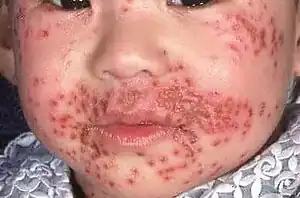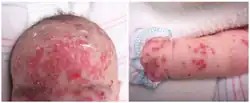Eczema herpeticum
| Eczema herpeticum | |
|---|---|
| Other names: Kaposi varicelliform eruption, pustulosis varioliformis acute, Kaposi-Juliusberg dermatitis | |
 | |
| Specialty | Dermatology |
| Complications | Secondary bacterial infection, blindness[1][2] |
| Duration | Up to six weeks |
| Causes | Herpes simplex virus (HSV) type 1 or 2[1] |
| Risk factors | Atopic dermatitis (eczema), other forms of dermatitis, burns, ichthyoses[2] |
| Diagnostic method | Based on symptoms, confirmed by testing[1] |
| Differential diagnosis | Impetigo, hand-foot-and-mouth disease, disseminated herpes zoster, disseminated molluscum contagiosum, dermatitis herpetiformis, eczema vaccinatum[2] |
| Treatment | Acyclovir, valacyclovir, supportive care[2] |
| Frequency | Rare[3] |
Eczema herpeticum is a widespread viral infection associated with small skin blisters.[1][2] The blisters generally begin in groups at the site of other skin problems and are painful.[2] They then break open to form small ulcers before developing a blood-stained crust.[2] Associated symptoms often include fever and swollen lymph nodes.[2] Healing generally occurs within six weeks.[2] Complications may include secondary bacterial infection and blindness.[1][2]
It is most commonly caused by a first episode of herpes simplex virus (HSV) type 1 or 2.[1] Those affected generally have atopic dermatitis (eczema); though it may also occur in other skin conditions such as other forms of dermatitis, burns, and ichthyoses.[2] Diagnosis is generally based on symptoms and may be confirmed by viral culture or PCR.[1] Coxsackievirus A16 or vaccinia virus (eczema vaccinatum) may produce a similar condition.[1]
Treatment should occur promptly with either acyclovir or valacyclovir.[2] Supportive care, including intravenous fluids, nutritional support, and pain medication may also be required.[2] Death is rare with appropriate treatment.[1][2] Some; however, are left with permanent loss of function.[2]
Eczema herpeticum affects about 3% of people with atopic dermatitis.[3] Children are more commonly affected than adults.[2] It was first described in 1887 by Moritz Kaposi.[1][3] Some use the term "eczema herpeticum" when it occurs in atopic dermatitis and "Kaposi varicelliform eruption" when it occurs in other skin conditions.[1]
Signs and symptoms
In addition to the skin, this infection affects multiple organs, including the eyes, brain, lung, and liver, and can be fatal.
.jpg.webp) Eczema herpeticum
Eczema herpeticum.jpg.webp) Eczema herpeticum
Eczema herpeticum.jpg.webp) Eczema herpeticum
Eczema herpeticum.jpg.webp) Eczema herpeticum
Eczema herpeticum Eczema herpeticum
Eczema herpeticum
Treatment
It can be treated with systemic antiviral drugs, such as aciclovir or valganciclovir.[4] Foscarnet may also be used for immunocompromised host with Herpes simplex and acyclovir-resistant Herpes simplex.
History
Eczema herpeticum was first described by Hungarian dermatologist Moriz Kaposi in 1887.[5] Fritz Juliusberg coined the term Pustulosis varioliformis acute in 1898.
Epidemiology
Even though the disease may develop at any age it is mostly present in childhood.[6] Those who are affected typically had pre-existing cutaneous condition like atopic dermatitis.[6]
See also
References
- 1 2 3 4 5 6 7 8 9 10 11 "Eczema herpeticum | DermNet NZ". dermnetnz.org. Archived from the original on 24 May 2022. Retrieved 20 June 2022.
- 1 2 3 4 5 6 7 8 9 10 11 12 13 14 15 16 Xiao, A; Tsuchiya, A (January 2022). "Eczema Herpeticum". PMID 32809616.
{{cite journal}}: Cite journal requires|journal=(help) - 1 2 3 Damour, Alexia; Garcia, Magali; Seneschal, Julien; Lévêque, Nicolas; Bodet, Charles (August 2020). "Eczema Herpeticum: Clinical and Pathophysiological Aspects". Clinical Reviews in Allergy & Immunology. 59 (1): 1–18. doi:10.1007/s12016-019-08768-3. ISSN 1559-0267. PMID 31836943.
- ↑ Xiao, Anny; Tsuchiya, Arline (2022). "Eczema Herpeticum". StatPearls. StatPearls Publishing. Archived from the original on 2022-11-06. Retrieved 2022-11-24.
- ↑ Reitamo, Sakari; Luger, Thomas A; Steinhoff, Martin (2008). Textbook of atopic dermatitis. Informa Healthcare. p. 70. ISBN 978-1841842462.
- 1 2 Liaw, Fang-Yih; Huang, Ching-Fu; Hsueh, Ju-Ting; Chiang, Chien-Ping (December 2012). "Eczema herpeticum". Canadian Family Physician. 58 (12): 1358–1361. ISSN 0008-350X. PMC 3520662. PMID 23242894. Archived from the original on 2021-01-26. Retrieved 2021-04-28.
External links
| Classification | |
|---|---|
| External resources |
- Eczema Herpeticum photo library at Dermnet Archived 2009-06-09 at the Wayback Machine